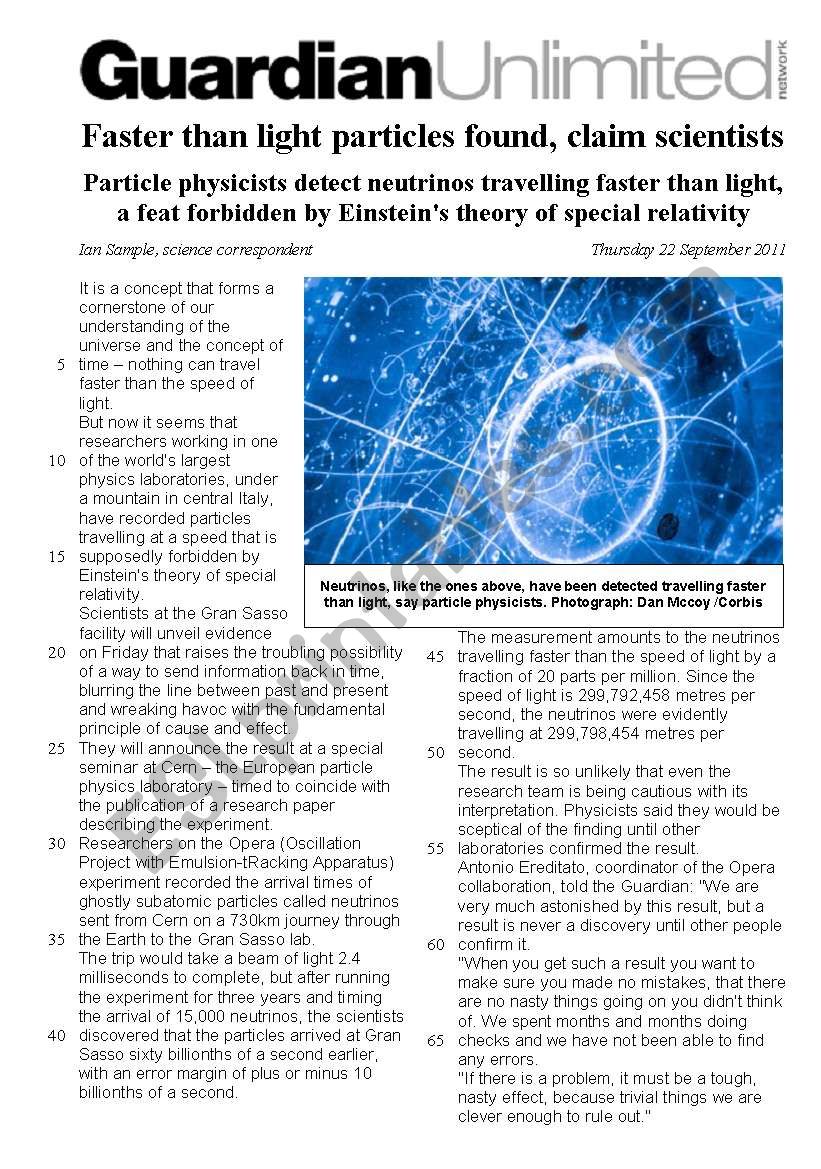
The OPERA team had timed neutrinos fired through Earth from the European particle physics laboratory, CERN, near Geneva, Switzerland, and found that they made the 730-kilometer trip to Gran Sasso 60 nanosecond faster than they would traveling at light speed. So instead of the nail in the coffin of faster-than-light neutrinos, the new suite of results is more like the sod planted atop their grave. The OPERA results were debunked months ago, however.

The OPERA team made headlines after they suggested neutrinos traveled 0.002% faster than light, thus violating Einstein's theory of special relativity. New results, announced today in Japan, contradict those announced last September by a 170-member crew working with the OPERA particle detector in Italy's subterranean Gran Sasso National Laboratory. Five different teams of physicists have now independently verified that elusive subatomic particles called neutrinos do not travel faster than light. The research was published in the journal Classical and Quantum Gravity.Enough already. Then we can talk about building the first prototypes.”
#Particle faster than light how to#
“The next step is to figure out how to bring down the astronomical amount of energy needed to within the range of today’s technologies, such as a large modern nuclear fission power plant. “This work has moved the problem of faster-than-light travel one step away from theoretical research in fundamental physics and closer to engineering,” Dr Lentz said. The astrophysicist said he would now focus his efforts on cooking up a workable version of the technology. Lentz says his imaginary warp drive would operate within the boundaries of physics. “Fortunately, several energy-saving mechanisms have been proposed in earlier research that can potentially lower the energy required by nearly 60 orders of magnitude.” Dr. “The energy savings would need to be drastic, of approximately 30 orders of magnitude to be in range of modern nuclear fission reactors,” Dr Lentz said. The contraption would require an enormous amount of energy that isn’t possible using modern technology. While his warp drive provides the tantalising possibility of faster-than-light travel, it’s still very much in the idea phase for now. He believes that solitons could travel faster than light and “create a conducting plasma and classical electromagnetic fields”.īoth of these concepts are understood under conventional physics and obey Einstein’s theory of relativity. These hyper-fast “solitons” can travel at any speed while obeying the laws of physics, according to a Göttingen University press release.Ī soliton – also referred to as a “warp bubble” – is a compact wave that acts like a particle while maintaining its shape and moving at constant velocity.ĭr Lentz said he cooked up his theory after analysing existing research and discovered gaps in previous warp drive studies. Spacecraft designs based on the theoretical shapes of different kinds of “warp bubbles.” E.

While other theories rely on “exotic” concepts, such as negative energy, his gets around this problem using a new theoretical particle. That’s because according to Einstein’s general theory of relativity, it’s physically impossible for anything to travel faster than the speed of light.ĭr Lentz, a scientist at Göttingen University in Germany, says his imaginary warp drive would operate within the boundaries of physics. So-called “warp drives” have been proposed before, but often rely on theoretical systems that break the laws of physics. In a recent study, physicist Dr Erik Lentz outlined a way that a rocket could theoretically travel faster than light – or over 186,000 miles per second.Īt that speed, astronauts could reach other star systems in just a few years, allowing humanity to colonise faraway planets.Ĭurrent rocket technology would take roughly 6,300 years to reach Proxima Centauri, the closest star to our Sun. It sounds like the stuff of science fiction, but spaceships that travel at warp speed are possible, according to one top scientist. Meteor traveling at 42,000mph rattles Vermont buildings Nasa rover releases its first audio clips from Mars Biggest asteroid to make ‘close approach’ to Earth this year is 3,000ft wideĬhina and Russia to build Moon base together – and may ban US astronauts


 0 kommentar(er)
0 kommentar(er)
